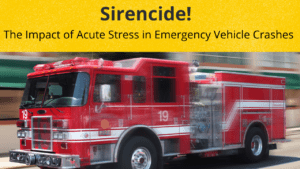This interview is with Dr. Dusty Lambert, a firefighter who completed his doctoral degree while researching the impact of acute stress in emergency vehicle crashes.
Emergency services provide an invaluable service to communities and cities around the world. Research has shown these professionals encounter significant acute psychological stress throughout their work shifts. Acute stress has been shown to impact human performance in various realms, from increased risk-taking to cognitive decline. While the actual work varies between firefighters, law enforcement, and emergency medical services, a shared commonality is the operation of emergency vehicles. Emergency vehicle crashes are recognized as a serious issue by FEMA. The current work aimed to measure the impact of acute stress on emergency responders as measured by fatal emergency vehicle crashes in the United States using a new variable: the type of call to which they were responding.
Utilizing data maintained by the United States Fire Administration, the study reviewed fatality data of firefighters who died in the line of duty from 2000 to 2019. Deaths from vehicle crashes while responding to emergency incidents were coded using details from the fatality narratives. Crashes that led to multiple firefighter fatalities were coded as a single case, yielding 144 cases. These were then weighted using nationwide response statistics to create an exposure variable for each type of incident. The exposure was calculated based on the estimated number of responses to each incident type, as well as the typical number of vehicles that respond to each type of incident.
The results showed a considerably higher ratio of cases occurring while responding to fires compared to all other types of emergencies. Firefighters encounter over nine times the likelihood of being involved in a fatal crash while responding to a fire. Specifically, structure-fire responses were determined to pose the highest risk of encountering a fatal crash during response. When compared to emergency medical incidents, which are the most common type of calls to which fire departments answer, structure-fire responses posed nearly 20 times the risk of a fatal crash occurring.
These results indicate that attempts to reduce motor vehicle crashes among emergency services should focus on human factors, specifically creating and implementing tools to reduce the acute stress and urgency produced by responses to certain incident types.
Episode length: 66 minutes
Click the YouTube meme to watch the full episode
About the Host
Richard B. Gasaway, PhD, CSP is widely considered a trusted authority on human factors, situational awareness and the high-risk decision making processes used in high-stress, high consequence work environments. He served 33 years on the front lines as a firefighter, EMT-Paramedic, company officer, training officer, fire chief and emergency incident commander. His doctoral research included the study of cognitive neuroscience to understand how human factors flaw situational awareness and impact high-risk decision making.
Contact us
www.SAMatters.com
www.RichGasaway.com
612-548-4424 (office)
Let’s Get connected
Facebook: SAMatters
LinkedIn: Rich Gasaway
LinkedIn: Situational Awareness Matters
Twitter: Rich Gasaway
Youtube: SAMattersTV
itunes: SAMatters Radio
Stitcher Radio: SAMatters Radio
Google Play: SAMatters Radio
iHeart Radio: SAMatters Radio
Firefighter Near Miss Reporting System
http://www.firefighternearmiss.com/
Dusty Lambert
dustylambert@gmail.com
The SAMatters Show is the longest running, fastest growing, safety focused weekly program on the Internet. If you know a company that might be interested in advertising their product or service to our listeners and viewers, ask them to contact us at SAMatters.com.


